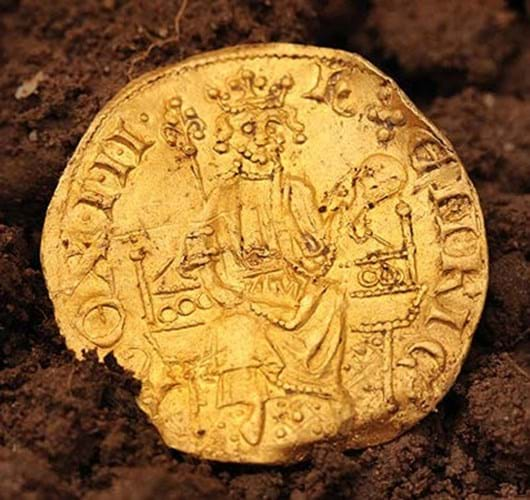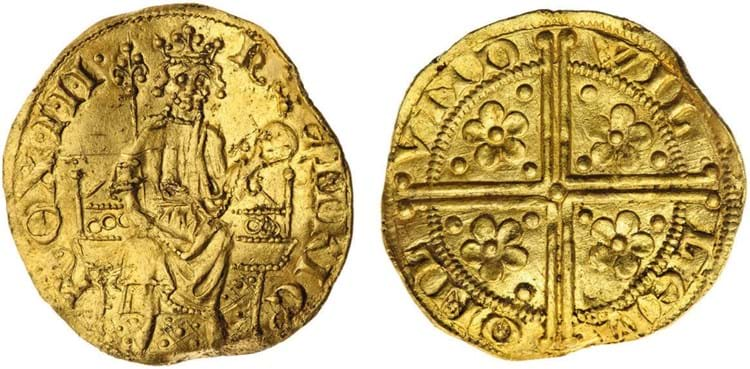Gregory Edmund, senior numismatist and auctioneer at Spink, described the metal-detecting find, sold in a special evening sale on January 23, as “on par with the discoveries of Coenwulf’s gold mancus in 2001 and the Edward III double-leopard in 2006”.
Those coins had sold for £200,000 and £400,000 respectively, each time breaking the record for an English coin.
Henry III (1216-72) issued his ‘gold penny’ for probably less than a year from August 16, 1357, at the moment when gold was beginning to trickle back into European commerce after nearly 500 years.
Struck by the king’s goldsmith William Fitzotto of Gloucester at twice the weight of a silver penny, with a value of 20 pence, one side of the coin shows Henry in the guise of England’s first patron saint Edward the Confessor, on his throne on the Great Pavement in Westminster Abbey.
The English archaeologist and numismatist Sir John Evans considered it the first ‘true’ portrait of an English king’. To the reverse is a cross with lobed terminals (designed to prevent ‘clipping’) and fiveleafed petals of the planta genista – the yellow flower that gave the Plantaganet dynasty its name.
Spink’s gold penny is thought to be the UK’s most valuable single coin find to date. Its sale represents a life-changing event for Michael Leigh-Mallory, 52, a retired ecologist from Cullompton who found the coin buried in just 4in (10cm) of soil on local farmland near the village of Hemyock on September 26 last year.
Not realising what it was, he posted a picture of the coin on social media, where it was spotted by a Spink specialist.
The ‘delightfully fresh’ condition suggests it was lost shortly after it was struck. And remarkably, following research by David Carpenter, professor of medieval history at King’s College London and a Henry III specialist, it is possible to speculate who may have lost it.
A good candidate is John de Hyden, Lord of Hemyock Manor. In 1357 he served on the retinue of the Earls of Devon during the Welsh campaign where over 37,000 gold pennies were distributed.
One of eight known
Ultimately the issue was not successful – many were melted down within a matter of months as the price of gold rose above the face value.
This coin adds one more to a small corpus of now just eight coins featuring four different die types. It shares a reverse die with the Conte specimen found in 2001 (now in the Fitzwilliam Museum, Cambridge) and the same ‘first obverse die’ with a coin in the British Museum since 1810. It appears to cement the proposed sequence of dies Sir John Evans posited in 1900.

A moving graphic of the coin being revealed from the soil was sold as an NFT for charity at a further £15,000.
The coin is one of only four available to commerce although there is a recent precedent: in January 2021, Heritage in Dallas sold another (previously sold at a Spink-Christie’s auction in 1996 at £145,000) for $600,000 (£465,000).
Spink’s coin was estimated at £200,000-300,000.
Leigh-Mallory will now split the proceeds of the sale with the landowner (under the terms of the Treasure Act) and plans to use his windfall to help fund his children’s education. The day after the sale he made a pilgrimage to Westminster Abbey to pay his respects at the tomb of Henry III.
In a first for numismatics, the second lot of the auction was an NFT (non-fungible token – a unit of data stored on a digital ledger) created and sold to benefit charities chosen by the vendor and Spink.
The six-second moving graphic of the coin being revealed after 765 years in the soil, complete with ownership title to its private and commercial licences, took a further £15,000.















